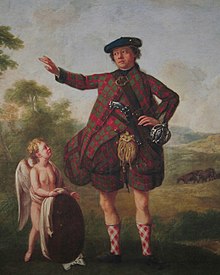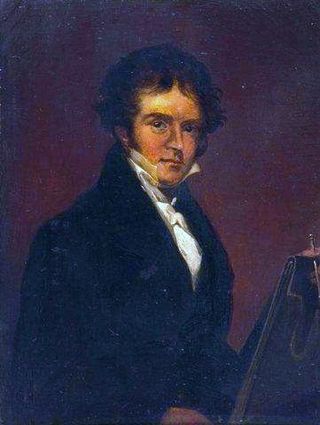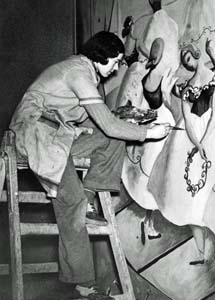
William Delacour (also known as William Delacourt or William De la Cour [1] ) (1700–1767) [2] was a French painter. He was active from 1741 until 1767. His work is held in the collection of the Cooper-Hewitt, National Design Museum. [3]

William Delacour (also known as William Delacourt or William De la Cour [1] ) (1700–1767) [2] was a French painter. He was active from 1741 until 1767. His work is held in the collection of the Cooper-Hewitt, National Design Museum. [3]
William Delacour is believed to have been either born in France or in Great Britain to French parents. From historical record, it is known that he became active in Great Britain in 1740. It was then that he was painting theatrical scenery. He created scenery for operas by Giovanni Battista Pescetti. He also may have designed works for John Rich. Around 1750, he published eight different books, called Books of Ornaments, about Rococo design. [1]
As of 1752, records show him calling himself a portrait painter. He worked in oil and pastels. He also painted landscapes in Dublin, Glasgow and Edinburgh.
He settled in Edinburgh in march 1760 and was appointed the first Master of the Trustees' Academy. He also worked for private clients, including interior decoration, such as the drawing room of Milton House on the Canongate. [4]
Delacour died in 1767 in Edinburgh. [1]

Sir Godfrey Kneller, 1st Baronet was a German-British painter. The leading portraitist in England during the late Stuart and early Georgian eras, he served as court painter to successive English and British monarchs, including Charles II of England and George I of Great Britain. Kneller also painted scientists such as Isaac Newton, foreign monarchs such as Louis XIV of France and visitors to England such as Michael Shen Fu-Tsung. A pioneer of the kit-cat portrait, he was also commissioned by William III of England to paint eight "Hampton Court Beauties" to match a similar series of paintings of Charles II's "Windsor Beauties" that had been painted by Kneller's predecessor as court painter, Peter Lely.

David Roberts was a Scottish painter. He is especially known for The Holy Land, Syria, Idumea, Arabia, Egypt, and Nubia, a prolific series of detailed lithograph prints of Egypt and the Near East that he produced from sketches he made during long tours of the region (1838–1840). These and his large oil paintings of similar subjects made him a prominent Orientalist painter. He was elected as a Royal Academician in 1841.

A portrait miniature is a miniature portrait painting, usually executed in gouache, watercolor, or enamel. Portrait miniatures developed out of the techniques of the miniatures in illuminated manuscripts, and were popular among 16th-century elites, mainly in England and France, and spread across the rest of Europe from the middle of the 18th century, remaining highly popular until the development of daguerreotypes and photography in the mid-19th century. They were usually intimate gifts given within the family, or by hopeful males in courtship, but some rulers, such as James I of England, gave large numbers as diplomatic or political gifts. They were especially likely to be painted when a family member was going to be absent for significant periods, whether a husband or son going to war or emigrating, or a daughter getting married.

John Smibert was a Scottish-born painter, regarded as the first academically trained artist to live and work regularly in British America.

Charles de Sousy Ricketts was a British artist, illustrator, author and printer, known for his work as a book designer and typographer and for his costume and scenery designs for plays and operas.

William Daniell (1769–1837) was an English landscape and marine painter, and printmaker, notable for his work in aquatint. He travelled extensively in India in the company of his uncle Thomas Daniell, with whom he collaborated on one of the finest illustrated works of the period – Oriental Scenery. He later travelled around the coastline of Britain to paint watercolours for the equally ambitious book A Voyage Round Great Britain. His work was exhibited at the Royal Academy and the British Institution and he became a Royal Academician in 1822.
James Alan Davie was a Scottish painter and musician.

Scottish art is the body of visual art made in what is now Scotland, or about Scottish subjects, since prehistoric times. It forms a distinctive tradition within European art, but the political union with England has led its partial subsumation in British art.

Gaetano Gandolfi was an Italian painter of the late Baroque and early Neoclassic period, active in Bologna.

Philippe Mercier was an artist of French Huguenot descent from the German realm of Brandenburg-Prussia, usually defined to French school. Active in England for most of his working life, Mercier is considered one of the first practitioners of the Rococo style, and is credited with influencing a new generation of 18th-century English artists.

William Linton (1791–1876) was a British landscape artist.

Charles-Michel-Ange Challe was a painter, draftsman and French architect.

Agostino Brunias was an Italian painter who was primarily active in the West Indies. Born in Rome around 1730, Brunias spent his early career as a painter after graduating from the Accademia di San Luca. After he befriended prominent Scottish architect Robert Adam and accompanied him back to Britain, Brunias left for the British West Indies to continue his career in painting under the tutelage of Sir William Young. Although he was primarily commissioned to paint the various planter families and their plantations in the West Indies, he also painted several scenes featuring free people of colour and cultural life in the West Indies. Brunias spent most of his West Indian career on the island of Dominica, where he would die in 1796. Historians have made disparate assessments of Brunias's works; some praised his subversive depiction of West Indian culture, while others claimed it romanticised the harshness of plantation life. Haitian revolutionary Toussaint Louverture was a prominent admirer of his work.

François Vivares was a French landscape-engraver, active in England.

Charles Pears was a British painter, illustrator and artist. His work was part of the art competitions at the 1928 Summer Olympics and the 1932 Summer Olympics.

Art in modern Scotland includes all aspects of the visual arts in the country since the beginning of the twentieth century. In the early twentieth century, the art scene was dominated by the work of the members of the Glasgow School known as the Four, led by Charles Rennie Mackintosh, who gained an international reputation for their combination of Celtic revival, Art and Crafts and Art Nouveau. They were followed by the Scottish Colourists and the Edinburgh School. There was a growing interest in forms of Modernism, with William Johnstone helping to develop the concept of a Scottish Renaissance. In the post-war period, major artists, including John Bellany and Alexander Moffat, pursued a strand of "Scottish realism". Moffat's influence can be seen in the work of the "new Glasgow Boys" from the late twentieth century. In the twenty-first century Scotland has continued to produce influential artists such as Douglas Gordon and Susan Philipsz.

Landscape painting in Scotland includes all forms of painting of landscapes in Scotland since its origins in the sixteenth century to the present day. The earliest examples of Scottish landscape painting are in the tradition of Scottish house decoration that arose in the sixteenth century. Often said to be the earliest surviving painted landscape created in Scotland is a depiction by the Flemish artist Alexander Keirincx undertaken for Charles I.
William Cowen was an English landscape painter. His work includes views of towns in Yorkshire, Italy, France, Ireland and particularly Corsica.

Phyllis Bray was a British artist and illustrator known for involvement in the East London Group of artists, for the murals she produced and for illustrating children's books. During her career she also exhibited at the Royal Academy and at several leading London galleries.
Marie Victor Ignace Poterlet also called Marie Poterlet,Victor Poterlet, and M. Victor Poterlet (1811–1889) was a 19th-century French wallpaper designer, engraver and printmaker. His work is held in the collections of the Bibliothèque nationale de France and the Cooper Hewitt Smithsonian Design Museum.